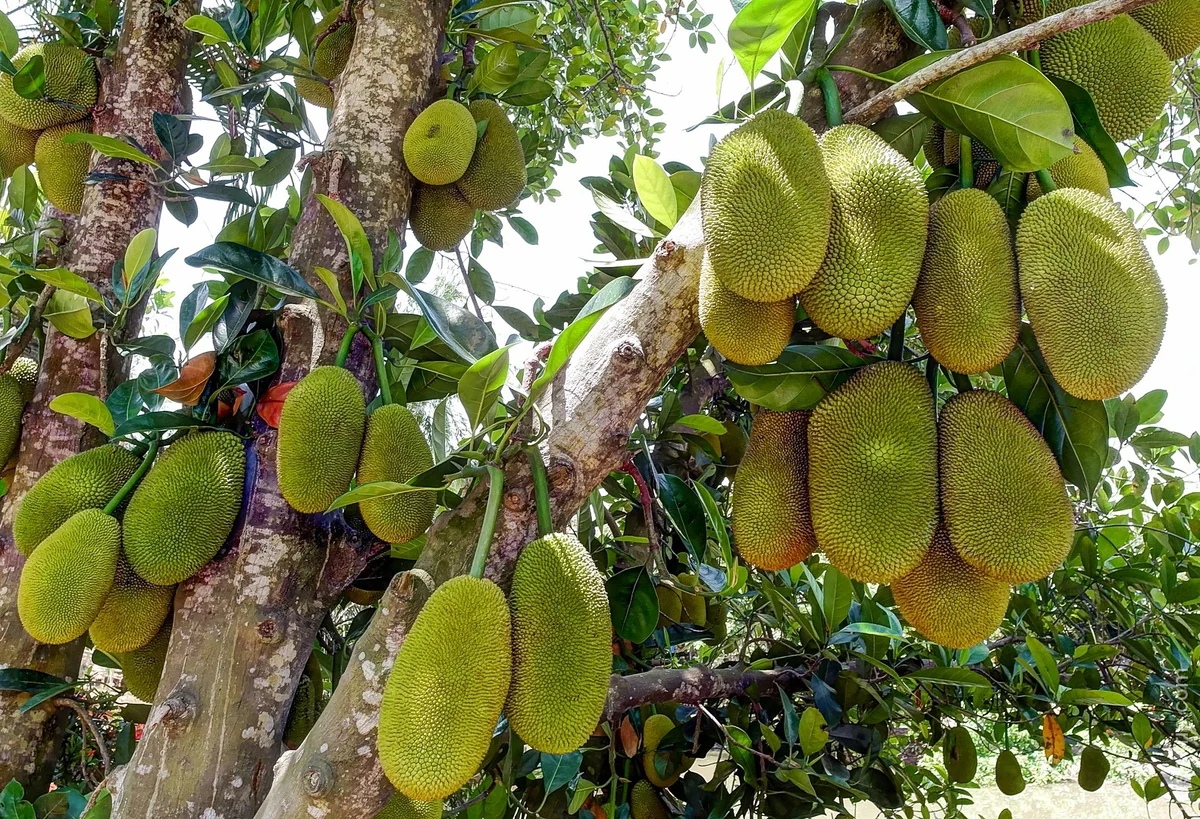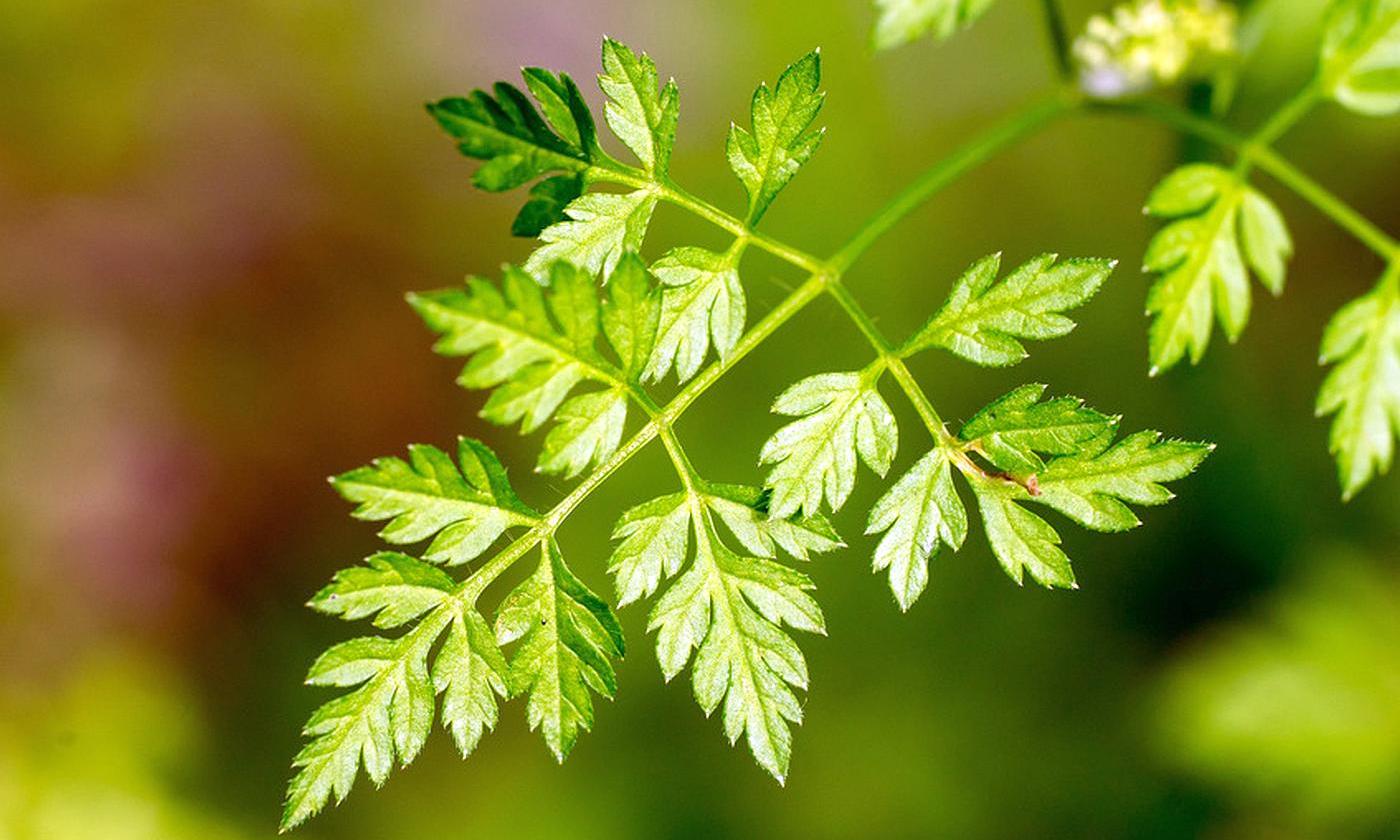On the shelves of shops, you can often find an interesting fruit - it looks like tiny oval oranges, and the taste is sour tangerine. This kumquat is a delicious and healthy citrus fruit that is eaten whole with the peel.
Kumquat is rarely grown from seed because it has a weak root system. In China and Japan, plants are inoculated with Poncirus trifoliata (three-leaf orange) for propagation. Often grown as a houseplant.
Fruit history
 The homeland of this fruit is Southeast Asia, and the name comes from its Cantonese name - Kam Kuat. It is also called kinkan, or fortunella. Its fiery red fruits with a delicate aroma can be confused with other citrus fruits in the photo, but in reality you will always distinguish kumquat from other fruits.
The homeland of this fruit is Southeast Asia, and the name comes from its Cantonese name - Kam Kuat. It is also called kinkan, or fortunella. Its fiery red fruits with a delicate aroma can be confused with other citrus fruits in the photo, but in reality you will always distinguish kumquat from other fruits.
Kumquat - very popular fruit not only in China and Southeast Asia, but also in Japan, in the Middle East - where there is a hot and humid climate with air temperatures up to 25-30 degrees. It grows both wild and cultivated - on huge plantations, and even at home. It is the smallest citrus fruit.
For the first time, kumquat was mentioned in ancient Chinese manuscripts, and a description was given to it at the beginning of the 12th century. In the Middle Ages, it became one of the most popular fruits in Japan, and in the middle of the 19th century became famous in Europe... The fruit was brought there by Scottish botanist Robert Fortune.
Kumquat in cooking
Due to its excellent taste properties, this fruit is eaten not only fresh, but also dried, dried, added to various hot and cold dishes - it goes well with pork, chicken and fish, perfectly complements desserts, cottage cheese dishes and yoghurts.
Kumquat makes wonderful sweet and sour sauces for dressing meat and vegetables. You can cook jam from fruits, make jelly, marmalade, candied fruits, and what a wonderful juice it makes! Delicate, aromatic, refreshing!
Kumquat as a medicinal plant
 All edible varieties are not only very tasty, but also literally stuffed with vitamins and healthy essential oils. Because of its unique properties, the kumquat is called the "golden fruit".
All edible varieties are not only very tasty, but also literally stuffed with vitamins and healthy essential oils. Because of its unique properties, the kumquat is called the "golden fruit".
The kumquat fruit contains up to 80 percent water, carbohydrates, fatty acids, valuable essential oils, monosaccharides, pectin substances, mineral compounds, and vitamins:
- C - almost 50 percent.
- Retinol (A).
- Niacin (B3), pantothenic acid (B5) and other B vitamins.
- Rutin.
- Tocopherol (E).
The peel of the fruit contains iron, manganese, copper, molybdenum. Kumquat has a unique property - it does not accumulate harmful nitrates in the pulp and skin, like many citrus fruits.
In addition, it is low in calories, it contains only 71 kcal per 100 g, and actively improves metabolic processes in the body. Due to these properties, it is often used in diets and for weight loss.
Medicinal properties of the fruit
 Just a storehouse of health - kumquat! That this is so, is confirmed by the inhabitants of the countries where it grows: there it is often used instead of medicines.
Just a storehouse of health - kumquat! That this is so, is confirmed by the inhabitants of the countries where it grows: there it is often used instead of medicines.
Dried fruits are no less useful than fresh ones: they form the substance firokoumarin - an effective "fighter" against fungal diseases.By the way, dried fruit is also a good remedy for a hangover, it is enough to chew a kumquat and the symptoms disappear.
Also the dried and fresh kumquat is excellent copes with depression and depressed mood, relieves apathy, has a beneficial effect on the body during stress and nervous tension. Kumquat is a fruit of joy, it improves mood and positively affects the nervous system.
Plus he activates brain activity, as a result of which it is recommended for those who are engaged in intellectual work.
This fruit is incredibly high in essential oils that are beneficial to the body. Therefore, in folk medicine, it became popular as a means for prevention and treatment colds, tonsillitis, cough, runny nose.
If you eat it regularly, then immunity increases, the general condition of the body improves. In addition, kumquat normalizes the digestive tract, prevents fungal diseases.
Also, this fruit has a positive effect on the cardiovascular system: the tincture of the fruit with honey significantly lowers cholesterol, fights diseases of blood vessels and heart muscle.
How to choose a kumquat when buying
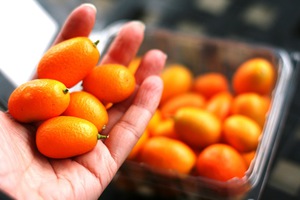 Wherever you buy a kumquat, be sure to inspect the fruit. The fruits should be smooth, without spots, damage.
Wherever you buy a kumquat, be sure to inspect the fruit. The fruits should be smooth, without spots, damage.
To the touch they should be moderately soft - the fruit is too hard unripe, too soft - overripe and may already be spoiling. The fruit should be rich in color.
Fresh fruit can be stored for three weeks in a cool place. You can also store them in the freezer - within six months, the fruits will not lose their beneficial properties.
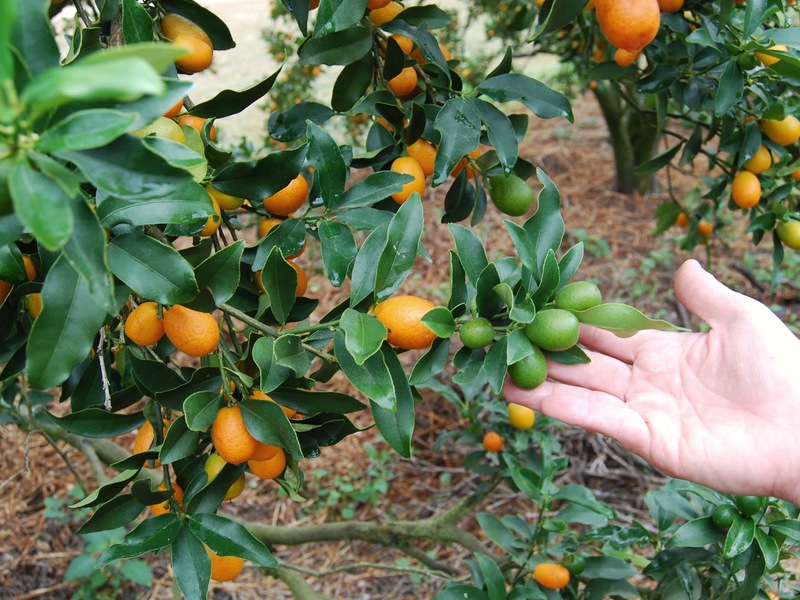

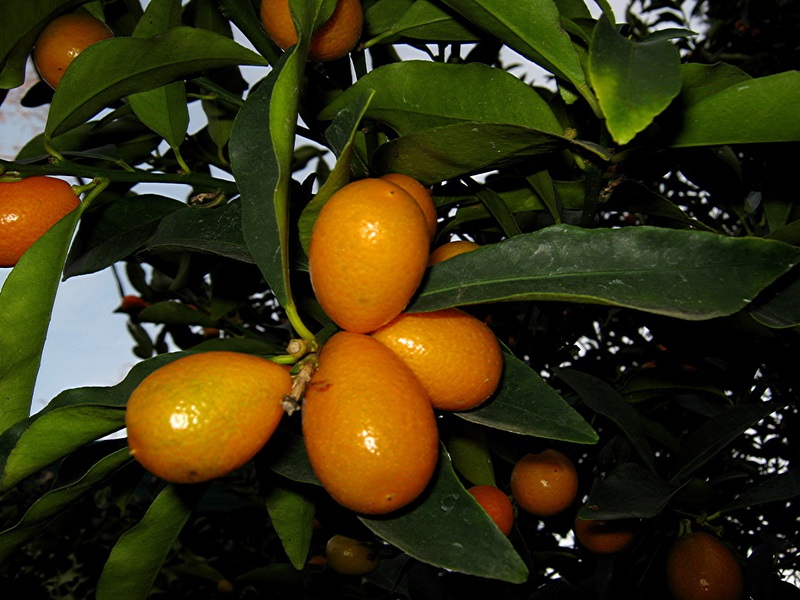
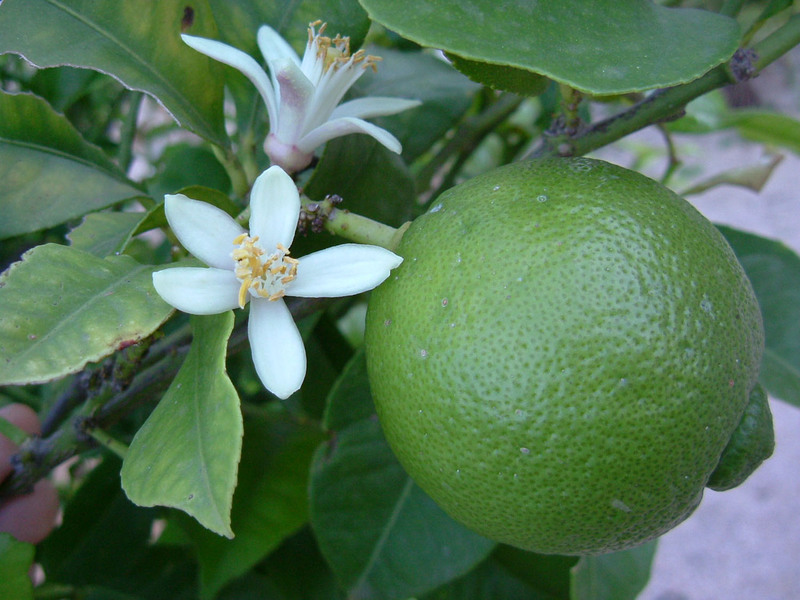
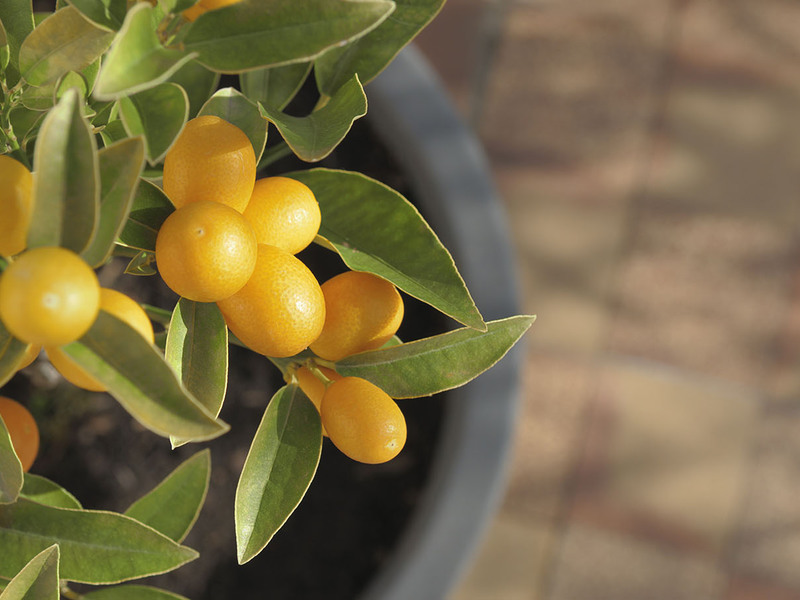
Kumquat is a low (up to 4.5 meters) evergreen shrub with oblong leaves. In July-August, it blooms with fragrant white and pink flowers, often blooms again after a few weeks.
The fruits ripen in December-January. The taste and color of the fruit depends on the variety. The following varieties are grown:
- "Nagami" is an orange variety with a tart sweet pulp, one of the most common types of kumquat; a variety of varieties - seedless "Nordmann nagami".
- "Marumi" is a hardy variety with round or oval fruits with a thin golden yellow skin and sour flesh.
- "Fukushi" is a variety with oval or pear-shaped fruits 5 cm long, common in Japan. It has a sweet and sour medium-juicy pulp, a smooth, thin rind that is orange in color and a very aromatic odor.
Some varieties of kumquat are hybrids:
- “Variegated” - hybrid of 1993, has oblong orange fruits with light green or light yellow stripes; the hybrid has no seeds, the taste is pleasant, sour, the pulp is very juicy.
- "Oranjekat nippon" is a "cross between" unshiu tangerine and kumquat. Despite the juicy sweet tasty fruits and the ability to withstand frosts down to -15 degrees, the hybrid is rare.
- Meiwa is a modification of the Nagami and Marumi varieties. Popular in China and Japan for its distinctive sweet and sour taste, reminiscent of lemon, thick and sweet rind and decorative appearance.
- "Limequat" is a hybrid obtained by crossing a kumquat and a lime. Limequat has small greenish-yellow fruits that grow on a miniature tree, smell of lime and have a bittersweet taste.
Some varieties are grown exclusively because of their decorative effect, while their fruits are inedible:
- "Hong Kong" - a variety common in China and Hong Kong, it has bright orange or red-orange small fruits no more than 2 cm in length;
- The "Malay" kumquat is cultivated in the Malay Peninsula as an ornamental plant due to its golden orange peel.
It is not always possible to understand which species a kumquat represents, a photo of varieties can help you figure it out, but in general, any edible type of fruit is very tasty and healthy.
Kumquat at home
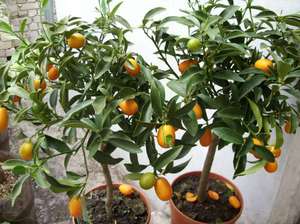 This plant can be grown as an indoor plant.The varieties Fukushi, Nagami and Marumi are best suited for these purposes. A low tree will perfectly decorate the interior with its decorative look, graceful flowers and bright fruits.
This plant can be grown as an indoor plant.The varieties Fukushi, Nagami and Marumi are best suited for these purposes. A low tree will perfectly decorate the interior with its decorative look, graceful flowers and bright fruits.
At home, the tree usually does not exceed one and a half meters, thanks to the compact crown, it is also possible to create bonsai from it. Its spectacular branches with fruits often used in floristry.
Kumquat breeds seeds, cuttings, layering, by vaccination. He loves light, nutritious soil, which contains leaf humus, sod, added vermiculite and coarse sand. It feels best in bright, diffused lighting and moderate watering.
With good care, the plant will delight for a long time with its catchy appearance and even bear fruit!

